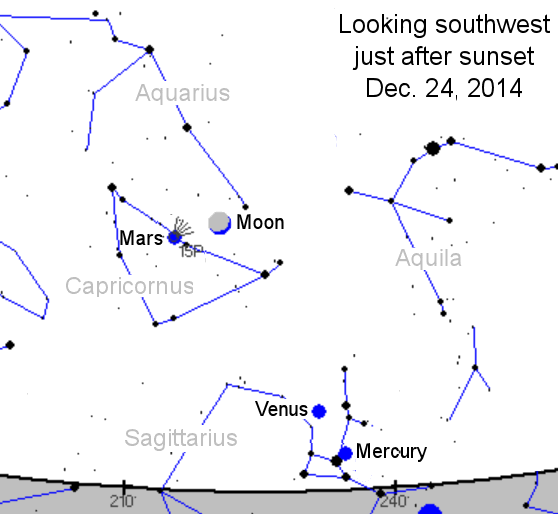.

According to the calendar, Christmas comes on Thursday, Dec. 25th. For backyard sky watchers, however, the holiday starts earlier. They're getting planets for Christmas—and the show begins on Dec. 22nd.
When the sun goes down on Monday before Christmas, Venus and a super-slender crescent Moon will pop out of the deepening twilight side by side. You'll need a clear view of the western horizon to see them. The pair are close to the sun and, thus, hanging very low in the sunset sky.

If you have trouble finding them because of the twilight glow, try scanning the west-southwest with binoculars. The bright light of Venus and the sharp edge of the crescent Moon are satisfying to see through handheld optics.
Go outside again on Tuesday evening, Dec. 23rd. Two nights before Christmas, you'll find the crescent Moon much higher and easier to see than the night before. Now it forms the midpoint of a curved line between Mars and Venus.
The arrangement is beautiful, but no more so than the Moon itself. Look inside the horns of the crescent: You will see a ghostly image of the full Moon. That's Earthshine—sunlight reflected from the clouds of our own planet onto the Moon, lighting up the dark and dusty lunar terrain. Some people say a crescent Moon with Earthshine is the prettiest sight in the heavens. You decide.
On Wednesday evening, Dec. 24th, the crescent Moon moves even higher in the sky for a Christmas Eve conjunction with the planet Mars. If there is a cylindrical object under your Christmas tree, unwrap it now. Using a telescope, you can see the ruddy disk of Mars only a few degrees from the mountains and hardened lava seas of the Moon.
Christmas night, Dec. 25th, brings an end to the show with one final alignment: Moon, Mars, Venus and—if you have a very clear view of the western horizon—Mercury emerging from the glare of the sun.
Bonus: If that telescope was a GOTO telescope, plug in the coordinates of Comet 2014 Q2, discovered just a few months ago by comet hunter Terry Lovejoy of Australia. On the nights around Christmas, "Comet Q2," as some are calling it, will glide just south of Sirius, the Dog Star, slowly brightening to naked-eye visibility. This green comet could be a beautiful sight in backyard optics.
.

Quelle: NASA
4642 Views
